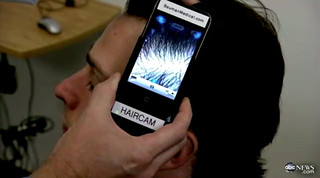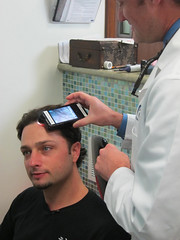Move that shampoo and conditioner aside. The pursuit of
luscious, shiny locks starts with fish, beans, bananas, and lentils.
Indeed, a healthy diet is as good for the 150,000 hair follicles on your head as it is for your body. "Having a balanced
diet, while putting a little extra emphasis on things like protein and
iron, gives your hair a boost," says Neil Sadick, a clinical professor
in the department of dermatology at the Weill Cornell Medical College.
Protein, for example, is the building block of hair. If you don't
get enough, your mane will grow more slowly, and strands will be
weaker. "Pump up the protein," says registered dietician Dawn Jackson
Blatner, author of
The Flexitarian Diet. "Include a small dose
at each meal and with each snack, and you'll keep your hair follicles
strong." Safe bets include poultry, lean beef, fish, beans, and nuts.
If you start a hair-healthy diet today, you'll likely see
improvements within six months to a year, depending on how fast your hair grows.
Try these 10 foods for your tresses:
Lean red meat. Too little iron can cause baldness,
according to research conducted at the Cleveland Clinic. Treating iron
deficiency may help regrow hair. "People who have problems with hair
loss or hair growth
tend to be iron deficient—especially women," says dermatologist Paradi
Mirmirani, who practices in Vallejo, Calif. Other iron-rich options
include turkey, egg yolks, whole grains, dried fruit, and dried beans
(soaked and cooked, of course).
 Eggs.
Eggs. They're full of biotin, a B vitamin that
promotes hair growth and overall scalp health. A deficiency can cause
brittle hair. Other high-biotin foods include peanuts, almonds, wheat
bran, salmon, low-fat cheese, and avocados.
Bananas, beer, oats, and raisins. These contain the
mineral silica, which is thought to improve hair thickness, Jackson
Blatner says. Emphasizing foods rich this mineral helps make hair
stronger and more durable. (Though beer contains a good dose of silica,
it's wise to stick to a moderate amount—one drink a day for women and
two for men.)
Dark green veggies. Load up on spinach, broccoli,
and Swiss chard. They're packed with vitamins A and C, which help
produce sebum—a scalp oil that works as a natural hair conditioner.
Oysters. Opt for these to get plenty of zinc, a
mineral that helps regulate the production of androgens. These are
hormones that, in low levels, are associated with hair loss. People
with low levels of androgens can also suffer from slow hair growth and
dandruff. Adjusting your diet—and emphasizing zinc-rich choices like
oysters, along with crab, clams, liver, lean beef, and wheat germ—will
help stave off hair loss and keep your mane shiny and healthy.
 Sweet potatoes.
Sweet potatoes. These are packed with
beta-carotene, which your body converts to vitamin A, a nourishing
agent for your hair and skin. Vitamin A protects against dull hair and
dry skin, a leading cause of dandruff. Other smart choices to get
glowing hair and skin include carrots, kale, butternut squash,
asparagus, and pumpkin.
Beans. Legumes like kidney beans and lentils are
great sources of iron-rich protein. Lentils, in particular, play a role
in hair maintenance and support.
 Fruits and veggies.
Fruits and veggies. They're full of vitamin C,
which helps your body absorb iron. Getting too little C makes hair dry
and weak. The best sources? Broccoli, leafy greens, green peppers,
citrus fruit, and strawberries.
Omega-3 fatty acids. They support scalp health; a
deficiency can lead to dry scalp and dull hair. Good sources include
salmon, sardines, herring, mackerel, flaxseeds, and walnuts.
Vegetable oil. No one wants dry, lackluster hair.
But if your diet is too low in fat, that's what could happen. Healthy
oils like olive, peanut, safflower, and sunflower can restore the
shine. About a teaspoon a day will do the trick.






 To
understand the process of hair loss, it’s important to understand how
our hair reproduces in the first place. Hair grows from tiny hair
follicles or living roots. The first phase of hair growth can last
anywhere from two to six years. Those with a longer phase can grow long
hair, those with a short growth phase can never grow hair past their
shoulders before it falls out and starts over. The next phase is a
resting phase. The hair stops growing as a new hair begins to replace it
in the follicle and push its way up. When that new hair reaches the top
of the root, the old, long hair will fall out or shed.
To
understand the process of hair loss, it’s important to understand how
our hair reproduces in the first place. Hair grows from tiny hair
follicles or living roots. The first phase of hair growth can last
anywhere from two to six years. Those with a longer phase can grow long
hair, those with a short growth phase can never grow hair past their
shoulders before it falls out and starts over. The next phase is a
resting phase. The hair stops growing as a new hair begins to replace it
in the follicle and push its way up. When that new hair reaches the top
of the root, the old, long hair will fall out or shed.






